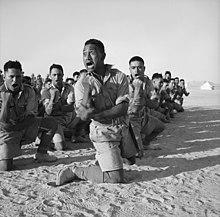Haka
[8] New Zealand sports teams' practice of performing a haka to challenge opponents before international matches has made the dance form more widely known around the world.
As Nathan Matthew explains, "it is a posture dance accompanied by chanted or shouted song... One of the main characteristics of haka are that actions involving all parts of the body are used to emphasise the words.
[21] Joseph Banks, who accompanied James Cook on his first voyage to New Zealand in 1769, later recorded: The War Song and dance consists of Various contortions of the limbs during which the tongue is frequently thrust out incredibly far and the orbits of the eyes enlarged so much that a circle of white is distinctly seen round the Iris: in short nothing is omitted which can render a human shape frightful and deformed, which I suppose they think terrible.
Henry Williams, the leader of the Church Missionary Society mission in New Zealand, aimed to replace haka and traditional Māori chants (waiata) with hymns.
The 1979 annual "haka party" parade at the University of Auckland – in which engineering students persisted in parodying haka by painting male genitals on their body and performing with sexually obscene gestures – was disrupted by a collection of Māori and Pacific Island students (He Taua, or The War Party) headed by Ngā Tamatoa, a prominent Māori activist group.
[32] The choreographed dance and chant popularized around the world by the All Blacks derives from "Ka Mate",[33] a brief haka previously intended for extemporaneous, non-synchronized performance, whose composition is attributed to Te Rauparaha (1760s–1849), a war leader of the Ngāti Toa tribe.
"Ka Mate" is about the cunning ruse Te Rauparaha used to outwit his enemies, and may be interpreted as "a celebration of the triumph of life over death".
[36][37] The Malay College Kuala Kangsar, a historically all-boys all-Malay prestige boarding school in Malaysia adopted the haka for their own rugby team in admiration of the New Zealand All-Blacks' popularity in the 1970s under the tutelarship of Neil Jonathan Ryan.
[40] In Indonesia, a culture of doing the 'Haka-haka' or its more commonly known variation 'Yel-yel' exist and performed by groups such as military personnel, law enforcement, civil servants, students, and others.
[44] In addition to the national Te Matatini ("many faces") festival,[8] local and regional competitions attract dozens of teams and thousands of spectators.
[50] The music video for the song "Poi E" (1983) by the Pātea Māori Club, written by Dalvanius Prime and Ngoi Pēwhairangi, used a mixture of kapa haka and hip-hop choreography.
This was then mixed with moves from Michael Jackson's Thriller music video as the outro song parody for Taika Waititi's movie Boy (2010).
[57][58] In March 2019, following the Christchurch mosque shootings, school pupils and other groups performed haka to honour those killed in the attacks.
[59] The choreography in the "Miroh" music video by South Korean boy band Stray Kids featured haka elements.
This appears to have begun at Kahuku High School where both the student body and local community includes many Polynesian Hawaiians, Māori, Samoans, Tahitians, and Tongans.
[64] On 14 November 2024, MP Hana-Rawhiti Maipi-Clarke led a haka inside the New Zealand Parliament to protest the Treaty Principles Bill, joined by Debbie Ngarewa-Packer, Rawiri Waititi, and other MPs.





